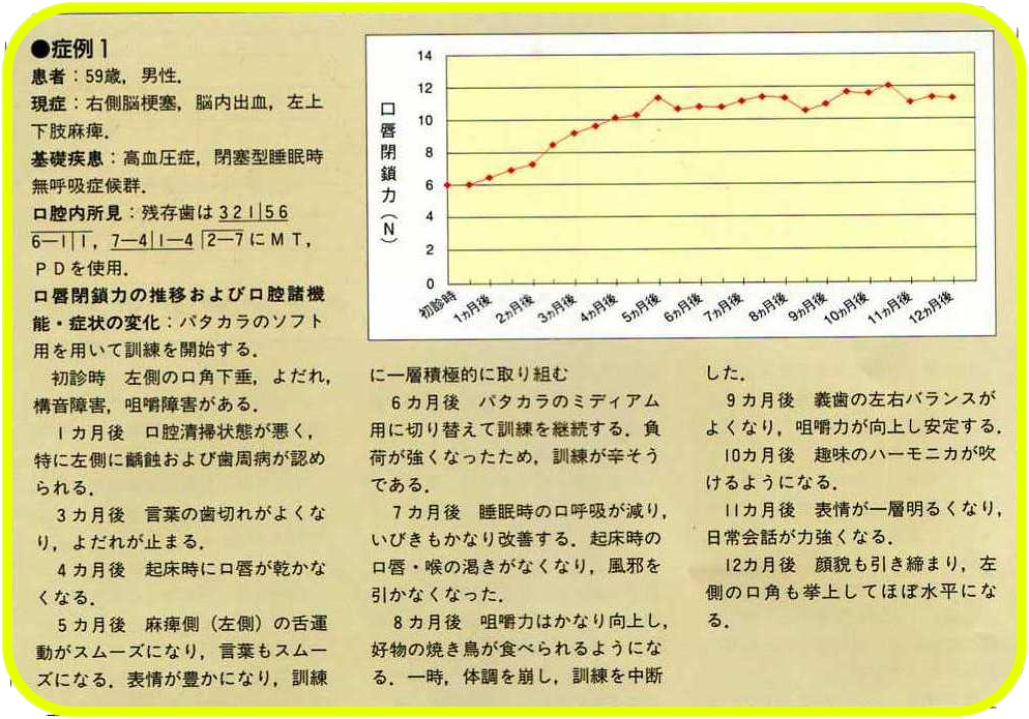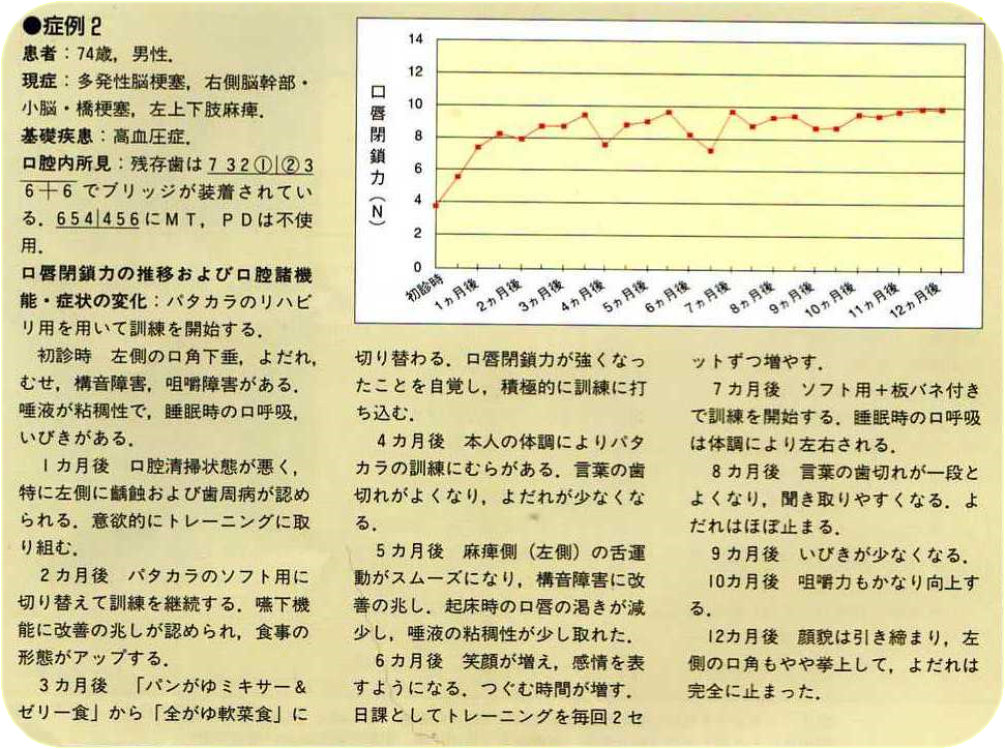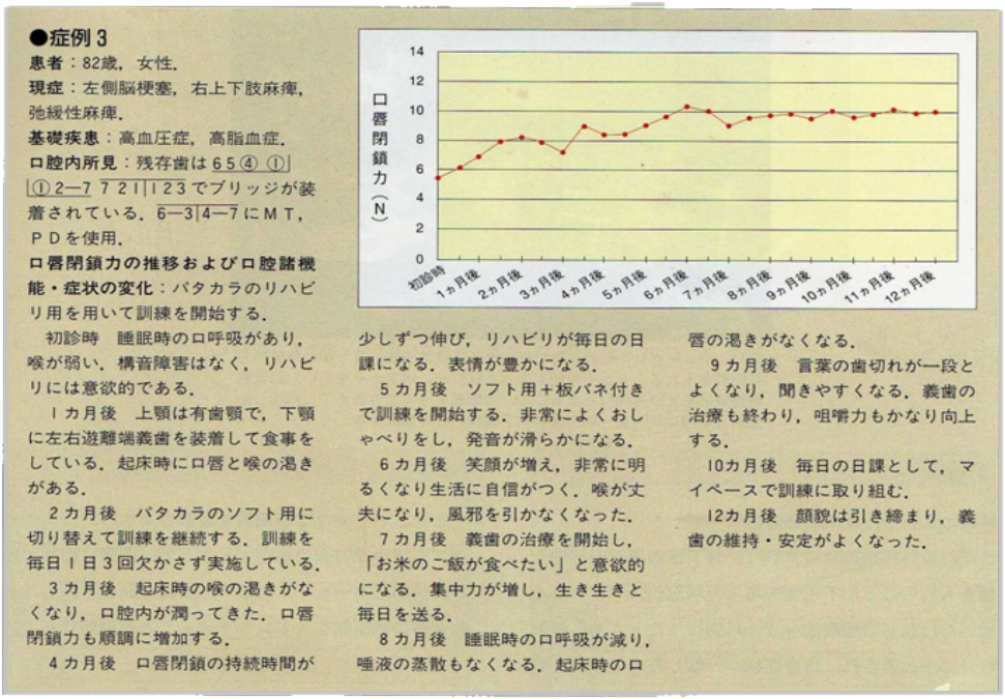Facial Paralysis / Post-Stroke Rehab / Swallowing & Speech / Snoring
Rehabilitation for Right Cerebral Infarction Using Patakara Training

Figure 8: Transition of Lip-Closing Strength Over One Year Using Patakara Functional Training. Patient is a 59-year-old male. Case of left-sided hemiparesis (upper and lower limbs) due to cerebral infarction (Underlying diseases: Hypertension, Obstructive Sleep Apnea Syndrome).
Case 1
59 years old, Male
Right cerebral infarction, Intracranial hemorrhage, Left-sided hemiparesis (upper and lower limbs)
Pre-existing conditions: Hypertension, Sleep Apnea
Changes in lip-closing strength and oral function/symptoms:
Initial visit: Left-sided drooping corner of the mouth, drooling, dysarthria, masticatory disorder.
1 month later: Oral hygiene was very poor, especially dental caries and periodontal disease found on the left side.
3 months later: Enunciation became clearer, no more drooling.
4 months later: Lips no longer dry upon waking.
5 months later: Tongue movement on the paralyzed (left) side became smooth, speech also became smooth. Facial expressions became richer, and he trained more actively.
6 months later: Switched to a trainer with a wider range of hardness. Due to the stronger elasticity, use became more strenuous.
7 months later: Reduced mouth opening during sleep, snoring improved significantly. No more dry lips or throat upon waking, no more occurrences of catching colds.
8 months later: Chewing strength significantly improved; could now eat grilled chicken skewers. Training temporarily interrupted due to physical discomfort.
9 months later: Balance of the left and right dentures improved, chewing became stronger and more stable.
10 months later: Able to play the harmonica.
11 months later: Facial expression became brighter, daily conversation became more vigorous.
12 months later: Facial muscles became firmer, the left corner of the mouth raised to a position nearly level (with the right).
Rehabilitation for Multiple cerebral infarctions Using Patakara Training

Case 2
Patient: 74-year-old, Male.
Current Condition: Multiple cerebral infarctions, right brainstem/cerebellum/pons infarction, left-sided hemiparesis (upper and lower limbs).
Underlying Disease: Hypertension.
Oral Findings:
Remaining teeth: T32①②③ (Note: Specific dental notation, translated literally), with a bridge attached at T6. MT at 554456, PD not in use. (Note: MT and PD likely refer to types of dental prostheses/appliances; translation kept close to original).
Changes in Lip-Closing Strength and Oral Function/Symptoms:
Began training using the rehab-type Patakara.
Initial visit: Left-sided drooping corner of the mouth, drooling, choking, dysarthria (articulation disorder), masticatory (chewing) disorder. Saliva was viscous, with mouth breathing during sleep and snoring.
1 month later: Oral hygiene was poor, particularly dental caries and periodontal disease observed on the left side. He trained actively.
2 months later: Switched to the soft-type Patakara and continued training. Signs of improvement in swallowing function were observed, and diet consistency was upgraded.
3 months later: Diet changed from "pureed bread porridge & jelly food" to "whole gruel soft diet". He became aware that his lip-closing strength had increased and trained more actively.
4 months later: Patakara training was sometimes skipped due to his physical condition. Enunciation was not clear. Drooling decreased.
5 months later: Tongue movement on the paralyzed (left) side became smoother, signs of improvement in dysarthria appeared, dry lips upon waking decreased, and saliva viscosity reduced slightly.
6 months later: Smiles increased, and he became more expressive. The duration of holding (likely the lip closure) increased. Added two sets of training per session as a daily routine.
7 months later: Began training with the soft type + plate spring attached. Mouth breathing during sleep varied depending on his physical condition.
8 months later: Enunciation became considerably clearer and easier to understand. Drooling almost stopped.
9 months later: Snoring decreased.
10 months later: Chewing strength improved considerably.
12 months later: Facial appearance became firmer, the left corner of the mouth was slightly elevated, and drooling stopped completely.
Stroke Rehabilitation Using Patakara Training

- Case 3
Patient: 82-year-old, female.
Presenting Condition: Left cerebral infarction, right upper and lower limb paralysis, flaccid paralysis.
Underlying Diseases: Hypertension, Hyperlipidemia.
Oral Findings: Remaining teeth: 65@①! ①②-7 7 2 1 1 2 3 with a bridge installed. M T, P D used on 6-3|4-7.
Changes in Lip Closure Strength and Oral Function/Symptoms: Began training using the rehab version of Patakara.
Initial Visit: Mouth breathing during sleep, weak throat. No dysarthria. Motivated for rehabilitation.
1 Month Later: Maxillary dentition is intact. Eats using removable partial dentures on the left and right free ends of the mandible. Experiences dry lips and throat upon waking.
2 Months Later: Switched to the soft version of Patakara and continued training. Performs training diligently 3 times daily without fail.
3 Months Later: Dry throat upon waking resolved. Oral moisture improved. Lip closure strength also increased steadily.
4 Months Later: The duration for which lips could remain closed gradually lengthened. Performs rehabilitation daily.
5 Months Later: Added the reinforcement bar to the trainer for training. Became more talkative. Pronunciation became smoother.
6 Months Later: Frequency of smiling increased. Became much brighter and more confident. Throat became healthier, no longer catches colds.
7 Months Later: Began formal denture fabrication. Requested to eat rice. Lively every day.
8 Months Later: Mouth breathing during sleep decreased. No more noticeable saliva evaporation. Dry lips upon waking resolved.
9 Months Later: Pronunciation improved significantly, became intelligible. Denture treatment completed. Chewing strength also greatly increased.
10 Months Later: Continues daily training according to her own condition.
12 Months Later: Facial muscles became firmer. Denture stability also improved.
Patakara
Exercises Help Restore Expression in patients with Facial Nerve Palsy
Patakara
Exercises Help Restore Expression in patients with Facial Nerve Palsy
- Ms. Hirakawa, Japan
It was the summer nine years ago when I suddenly experienced facial nerve paralysis. I was talking with a friend, and the right side of my face suddenly drooped completely and became immobile. I suspect it might have been caused by the air conditioner blowing on my right face the night before, combined with the air conditioning on the train ride to my friend's villa. In any case, the entire right side of my face drooped, eating became difficult, and my speech became unclear. While I was still in a state of panic and despair, the internal medicine doctor prescribed tranquilizers and sleeping pills along with starting treatment for the facial issue. I spent my days taking medicine and then sleeping.
However, the paralysis showed no improvement. After about a month, I gave up on drug treatment and subsequently tried acupuncture, qigong, chiropractic, visible light therapy, negative ion therapy, cupping—I tried every treatment method available.
But none of the treatments produced satisfactory results. Over eight years, the only continuous treatment was acupuncture, which was only slightly better than doing nothing at all. Finally, the doctor told me I would just have to accept this condition.
Four or five years later, the paralysis began to worsen. Originally, it was just the right side of my face that drooped and couldn't move, but suddenly my face started to atrophy, my eye became smaller, and my nose and mouth became twisted and slanted. This situation made me anxious and fearful, and I became even more reluctant to go out. Furthermore, my body became prone to colds, I had low blood pressure, heart problems, and my skin became rough.
I had considered the last resort: "surgery to transplant a nerve from the armpit to the face." However, I heard that after the surgery, some people experienced unnatural movement and pain, which made me hesitant. In April of Heisei year 12 (2000), just as I had resolved to undergo the surgery, I saw an article in the newspaper about Patakara Oral Muscles Strength Training Exercises. Patakara Exercises seemed to involve placing a trainer device between the gums and the upper and lower lips, then closing the lips to train the muscles around the mouth and enhance the body's natural healing power. I immediately told Dr. Yoshihiro Akihiro, about my situation. Surprisingly, Mr. Akihiro told me easily that it could be cured.
For me, who had been told for nine years that "the nerve is dead, it can't be cured," this was astonishing. Renewed hope brought me to tears, and I decided on the spot to use it. The Patakara comes in three levels of hardness. The closing strength of my lips was equivalent to that of a young child, about 5-6 Newtons. At first, I couldn't even close the softest one. By practicing hard and holding the device with my hand, I managed to close it.
About one week after starting the Patakara Exercises, I tried sleeping without the dental splint I had been using for eight years between my upper and lower teeth. This splint was meant to reduce the movement of my paralyzed teeth during sleep. If I slept without it, my bite would worsen overnight, causing tooth pain, and the next day I would have a stiff neck, headache, and nausea. Wearing the splint was uncomfortable; my mouth couldn't close, and I could only breathe through my mouth. These issues made me decide to try sleeping without it. As a result, not only was there no pain like before, but I also felt refreshed the next morning. I thought I probably didn't need the splint anymore.
Around two weeks, my teeth started to move. Just as I felt the step difference between my left and right upper front teeth was reducing, my lower teeth also began to readjust. Simultaneously, my atrophied face started to loosen bit by bit, my eye opened wider, my mouth opened better, and my nose slowly straightened. Although my teeth and face haven't fully regained balance, I believe within half a year I should recover to a point where I won't feel embarrassed meeting people.
What made me even happier was that as my skin and muscles regained strength, facial expressions started to return. Since the onset, my face had become expressionless and dull. Because the muscles couldn't move, I couldn't express joy, anger, sorrow, or pleasure, and I didn't want to make expressions either, as all my energy was spent on hiding the paralysis, leaving no strength for expressions.
Furthermore, my skin became smoother, my blood pressure rose, and my electrocardiogram stabilized. Within one or two months, my lip closing strength increased to 10N (the average for women is 10-13N). My current method is to use the hardest level to increase the closing time, closing with full effort until I can't hold it anymore, then resting briefly, and repeating this for 10 minutes. I do this four times a day and record the number of repetitions.
Through this effort, my closing strength, which had stalled at 10N, rose to 13.4N. Lately, the muscles in my right cheek and around my nose, which still show paralysis, have started twitching several times a day. It feels like the moment of recovery is getting closer. Perhaps because the muscles are starting to move, my nose has shown slight bending to the right again, but I believe that through repeated training, the paralysis will ultimately be cured and my nose will straighten again.
Advice from Dr. Akihiro
Ms. Hirakawa was surprised when her nose, which had started to straighten, began to bend again after two weeks of use. However, she was reassured when her nose straightened again as the muscles on the paralyzed right side regained strength.
The method of using a lighter force to increase lip closing time was devised by Ms. Hirakawa herself. Indeed, when closing the lips with greater force, it trains the larger muscles. To maintain the strength of the finer muscles, training with a lighter force is necessary to build muscle endurance. I believe Ms. Hirakawa's correct method awakened the sensation around her nose and cheeks.
